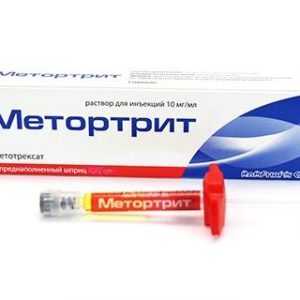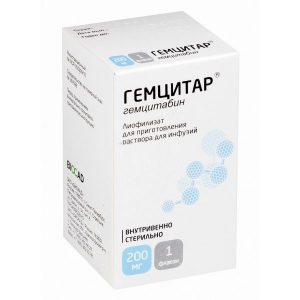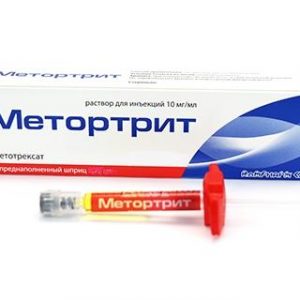Description
Latin name
METHOTREXAT-EBEWE
Release form
Tablets.
Packaging
In a polypropylene bottle 50 tablets. In a cardboard box 1 bottle.
Pharmacological action
Pharmacodynamics
Antitumor drug from the group of antimetabolites – analogues of folic acid. Along with antitumor, it has an immunosuppressive effect.
Inhibits dihydrofolate reductase, which is involved in the reduction of dihydrofolic acid to tetrahydrofolic acid, a carrier of carbon fragments necessary for the synthesis of purine nucleotides and their derivatives.
Slows down synthesis, DNA repair and cell mitosis (in S-phase). Particularly sensitive to the action of methotrexate are tissues with high cell proliferation: tumor tissue, bone marrow, epithelial cells of the mucous membranes, embryonic cells. Moreover, methotrexate has immunosuppressive properties.
Pharmacokinetics
Absorption
Absorption from the gastrointestinal tract when administered orally depends on the dose: when taken 30 mg / m2 is absorbed well, the average bioavailability is 50%. Absorption decreases when taken in doses> 80 mg / m2 (probably due to saturation). Food slows the absorption of methotrexate and reduces Cmax. Tmax is 1-2 hours when taken orally and 30-60 minutes – with a / m introduction.
Distribution of
Plasma Protein Binding – About 50%.
When taken in therapeutic doses, regardless of the route of administration, methotrexate practically does not penetrate the BBB (after intrathecal administration, high concentrations are achieved in the cerebrospinal fluid). Excreted in breast milk.
Metabolism
After ingestion, methotrexate is partially metabolized by the intestinal flora, the main part is in the liver (regardless of the route of administration) with the formation of a pharmacologically active polyglutamine form that inhibits dihydrofolate reductau and thymidine synthesis.
Excretion of
T1 / 2 in the initial phase is 2-4 hours, and in the final phase (which is long) is 3-10 hours when using conventional doses and 8-15 hours when using high doses of the drug.
It is excreted unchanged mainly with urine by glomerular filtration and tubular secretion (with iv administration of 80-90% excreted within 24 hours), with bile excreted up to 10% (with subsequent reabsorption in the intestine). With repeated injections, it accumulates in the tissues in the form of metabolites.
Pharmacokinetics in special clinical cases
In children with leukemia, absorption ranges from 23 to 95%.
In chronic renal failure, both phases of drug elimination can be significantly prolonged. Withdrawal of the drug in patients with impaired renal function, expressed as ascites or transudate is significantly slowed down.
Indications
Trophoblastic tumors
acute lymphoblastic and myeloid leukemia
neuroleukemia
non-Hodgkin lkmfoma, including lymphosarcoma
breast cancer, lung carcinoma, squamous cell carcinoma of the lung, carcinoma of the lung, carcinoma of the lung, carcinoma of the lung, carcinoma of the lung, carcinoma of the lung, carcinoma of the lung, carcinoma of the lung, cervical cancer, renal carcinoma, pulmonary carcinoma, renal carcinoma, pulmonary carcinoma, renal carcinoma, lung cancer bladder cancer, testicular cancer, ovarian cancer, penile cancer, retinoblastoma, medulloblastoma
osteogenic sarcoma and soft tissue sarcomas
fungoid mycosis (advanced stages)
severe forms of psoriasis, psoriatic arthritis, rheumatoid arthritis, dermatomyositis, non-standardized spondylitis, anemia, non-spondylitis, anemia
Contraindications
Severe anemia, leukopenia, neutropenia, thrombocytopenia
renal failure
hepatic insufficiency
pregnancy
breastfeeding period
hypersensitivity to any other drug.
With caution: the drug should be used for ascites, effusions in the pleural cavity, gastric and duodenal ulcer, ulcerative colitis, dehydration, gout or nephrolithiasis in the anamnesis, previous radiation therapy or chemotherapy, infectious diseases of a viral, fungal or bacterial nature.
Use during pregnancy and lactation
Use of the drug during pregnancy and during breast-feeding is contraindicated.
Men and women of childbearing age should be treated with reliable methods of contraception during treatment with methotrexate and for at least 3 months after.
Composition
1 tablet contains:
Active substances: methotrexate 5 mg.
Excipients: lactose monohydrate, corn starch, microcrystalline cellulose, colloidal silicon dioxide, magnesium stearate.
Dosage and administration of
Methotrexate is part of many chemotherapeutic regimens, and therefore, when choosing a route of administration, regimen and dose in each individual case, one should be guided by the data of the specialized literature.
Methotrexate-Ebeve for injection may be given i.v., i.v., i.v. or intrathecal. Methotrexate-Ebeve tablets should be taken orally before meals, without chewing.
With trophoblastic tumors – 15-30 mg orally or IM daily for 5 days at intervals of? 1 week (depending on signs of toxicity). Or 50 mg once every 5 days with an interval of? 1 month. Treatment courses are usually repeated 3 to 5 times to a total dose of 300-400 mg.
For solid tumors in combination with other antitumor drugs – 30-40 mg / m2 iv in a jet once a week.
With leukemia or lymphoma – 200-500 mg / m2 by iv infusion once every 2-4 weeks.
In case of neuroleukemia – 12 mg / m2 intrathecal for 15-30 seconds 1 or 2 times a week.
In the treatment of children, the dose is selected depending on age: children under 1 year of age are prescribed 6 mg
for children under 1 year of age – 8 mg
for children under 2 years of age – 10 mg
for children over 3 years of age – 12 mg.
Before administration, the volume of cerebrospinal fluid should be removed, approximately equal to the amount of drug that is supposed to be administered.
When using high-dose therapy, from 2 to 15 g / m2 in the form of a 4-6-hour iv infusion with an interval of 1-5 weeks with mandatory subsequent administration of calcium folinate, which usually begins 24 hours after the start of methotrexate infusion and is administered every 6 hours at a dose of 3-40 mg / m2 (usually 15 mg / m2) and higher depending on the concentration of methotrexate in serum for 48-72 hours.
With rheumatoid arthritis, the initial dose is usually 7.5 mg 1 time per a week, which is administered at the same time in / in, / or inside – 2.5 mg every 12 hours (3 doses in total). The day the optimum effect is achieved, the weekly dose can be increased, but it should not exceed 20 mg. When an optimal clinical effect is achieved, dose reduction should begin until the lowest effective dose is achieved. The optimal duration of therapy is not known.
For psoriasis by mouth, intramuscularly or intravenously in doses of 10 to 25 mg per week. The dose is usually increased gradually, upon reaching the optimal clinical effect, the dose is reduced to the lowest effective dose.
With mushroom mycosis i / m 50 mg once a week or 25 mg 2 times a week or orally 2.5 mg / day for several weeks or months. Dose reduction or withdrawal of the drug is determined by the patient’s response and hematological parameters.
Side effects of
From the hemopoietic system: leukopenia, neutropenia, lymphopenia (especially T-lymphocytes), thrombocytopenia, anemia.
From the digestive system: anorexia, nausea, vomiting, stomatitis, gingivitis, glossitis, pharyngitis rarely – enteritis, diarrhea, ulcerative gastrointestinal lesions, gastrointestinal bleeding in some cases (with prolonged daily use) – impaired liver function, increased activity of hepatic transaminases, periportal fibrosis and cirrhosis of the liver, necrosis of the liver, fatty degeneration of the liver, pancreatitis.
From the side of the central nervous system and peripheral nervous system: encephalopathy (with the introduction of multiple doses intrathecal, radiation therapy in the skull), fatigue, weakness, confusion, ataxia, tremor, irritation, convulsions, coma with intrathecal administration of methotrexate – dizziness, blurred vision , headache, back pain, stiff neck, cramps, paralysis, hemiparesis.
From the respiratory system: rarely – interstitial pneumonitis, pulmonary fibrosis, exacerbation of pulmonary infections.
From the urinary system: cystitis, nephropathy, impaired renal function (increased creatinine, hematuria).
From the reproductive system: violation of the process of oogenesis, spermatogenesis, decreased libido / impotence, change in fertility, teratogenic effects.
From the sensory organs: conjunctivitis, excessive lacrimation, cataracts, photophobia, cortical blindness (when used in high doses), impaired vision.
Dermatological reactions: skin erythema and / or rash, itchy skin, telangiectasia, furunculosis, depigmentation or hyperpigmentation, acne, peeling of the skin, folliculitis, alopecia (rarely), exacerbation of radiation dermatitis.
Allergic reactions: fever, chills, rash, urticaria, anaphylaxis, malignant exudative erythema (Stevens-Johnson syndrome), toxic epidermal necrolysis (Lyell syndrome), photosensitivity.
Other: immunosuppression (decreased resistance to infectious diseases), malaise, osteoporosis, hyperuricemia, vasculitis, arthralgia / myalgia.
Drug Interaction
When co-administered with high doses of methotrexate with various NSAIDs (including aspirin and other salicylates, azaproxone, dichlofenac, indomethacin, and ketoprofen), methotrexate toxicity may be increased. In some cases, severe toxic effects, sometimes even fatal, are possible. The use of methotrexate in low doses (7.5-15 mg per week), in particular in the treatment of rheumatoid arthritis, in combination with NSAIDs is not contraindicated, subject to special precautions and appropriate monitoring. srdl sr srl at the same time as sulfanilamide, sulfonylurea, phenytoin, phenylbutazone, aminobenzoic acid, probimetric, trimethoprim, chlorophyll, Antibiotics, poorly absorbed from the gastrointestinal tract (including tetracyclines, chloramphenicol), reduce the absorption of methotrexate and impair its metabolism due to the suppression of the normal intestinal microflora.
When used with methotrexate, retinoids, azathioprine, and sulfasalazine increase the risk of hepatotoxicity. Parenteral use of acyclovir against the background of intrathecal administration of methotrexate increases the risk of neurological disorders.
With the simultaneous use of methotrexate with multivitamin preparations containing folic acid or its derivatives, the effectiveness of methotrexate therapy may be reduced.
L-asparaginase is a methotrexate antagonist.
Anesthesia with dinitrogen oxide on methotrexate therapy can lead to the development of unpredictable severe myelosuppression and stomatitis.
When used with methotrexate, amiodarone may promote skin ulceration.
Methotrexate reduces the clearance of theophylline.
Several patients with psoriasis or fungal mycosis receiving methotrexate in combination with PUVA therapy (methoxalene and UFO) have been diagnosed with skin cancer.
Caution should be exercised when administering erythrocyte mass and methotrexate.
Combination of methotrexate therapy with radiotherapy may increase the risk of soft tissue necrosis.
Methotrexate may reduce the immunological response to vaccination while co-administration with a live vaccine may produce severe antigenic reactions.
Overdose
Treatment: Immediately, preferably within the first hour, the introduction of a specific antidote – folinate folate at a dose equal to or greater than the methotrexate dose should be given as necessary, depending on the serum methotrexate concentration. To prevent the precipitation of methotrexate and / or its metabolites in the renal tubules, hydration and alkalinity of the urine are performed.
In case of overdose with intrathecal administration, repeated lumbar punctures should be performed immediately to ensure rapid drainage of cerebrospinal fluid. Neurosurgical intervention with ventriculolumbar perfusion is possible. All of these procedures should be performed against the background of intensive maintenance therapy and systemic administration of high-dose folinate calcium.
Storage conditions
Keep out of the reach of children, protected from light, at a temperature not exceeding 25 ° C.
Expiration
3 years.
Active ingredient
Methotrexate
dosage form
dosage form
tablets




